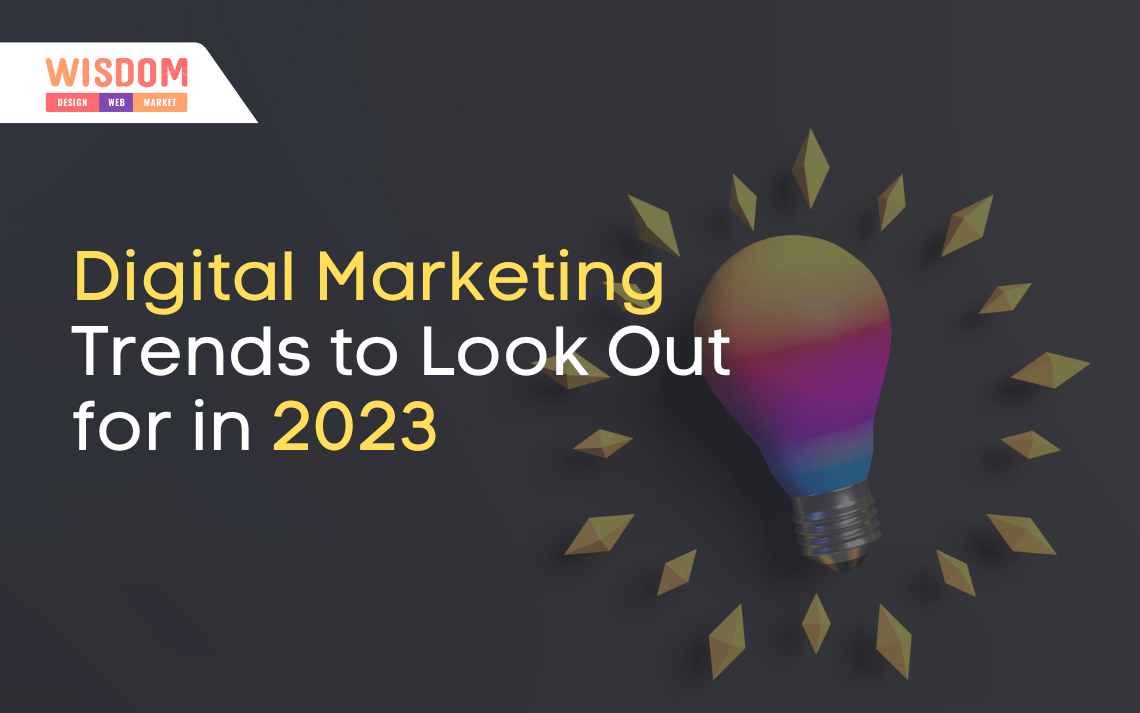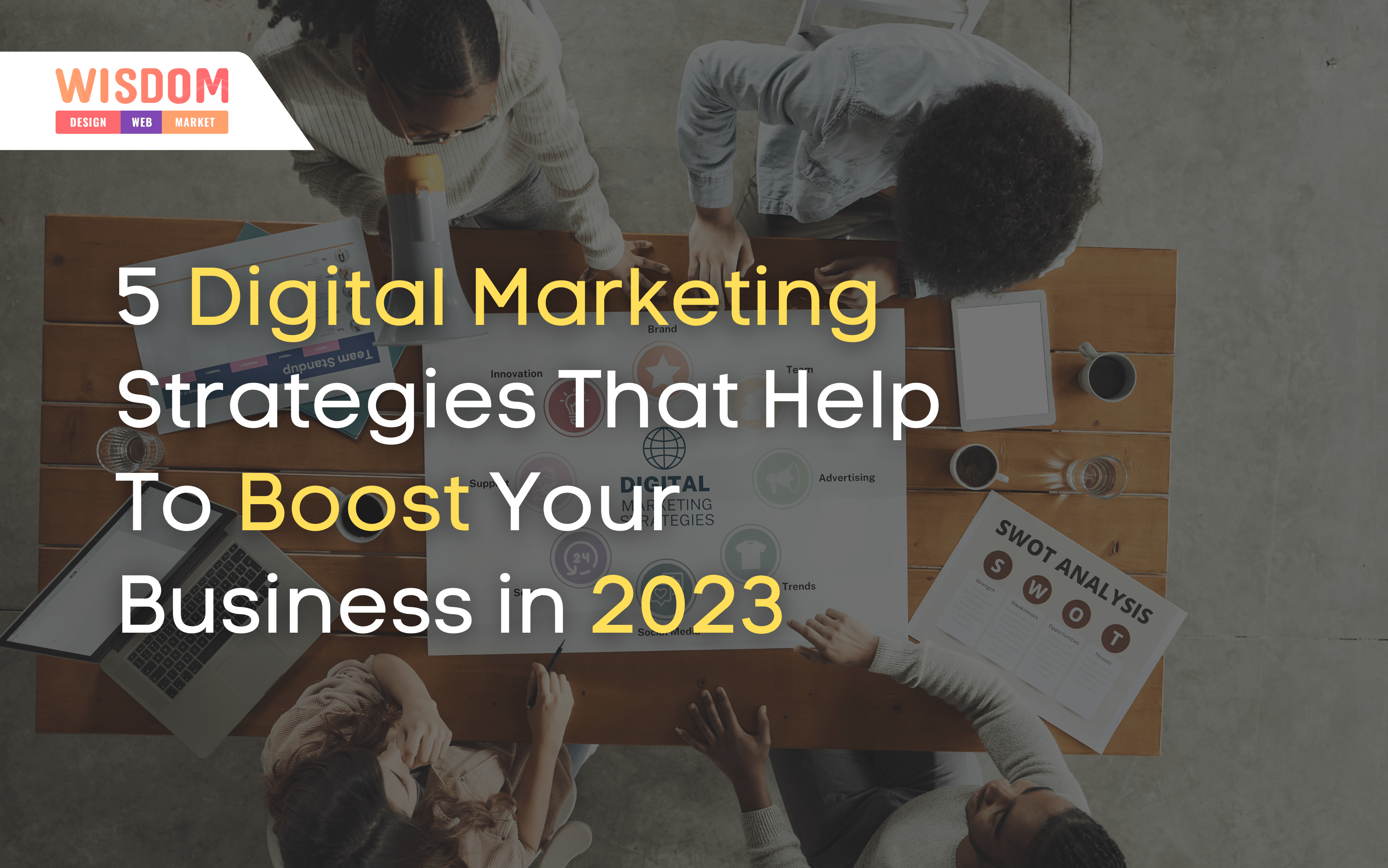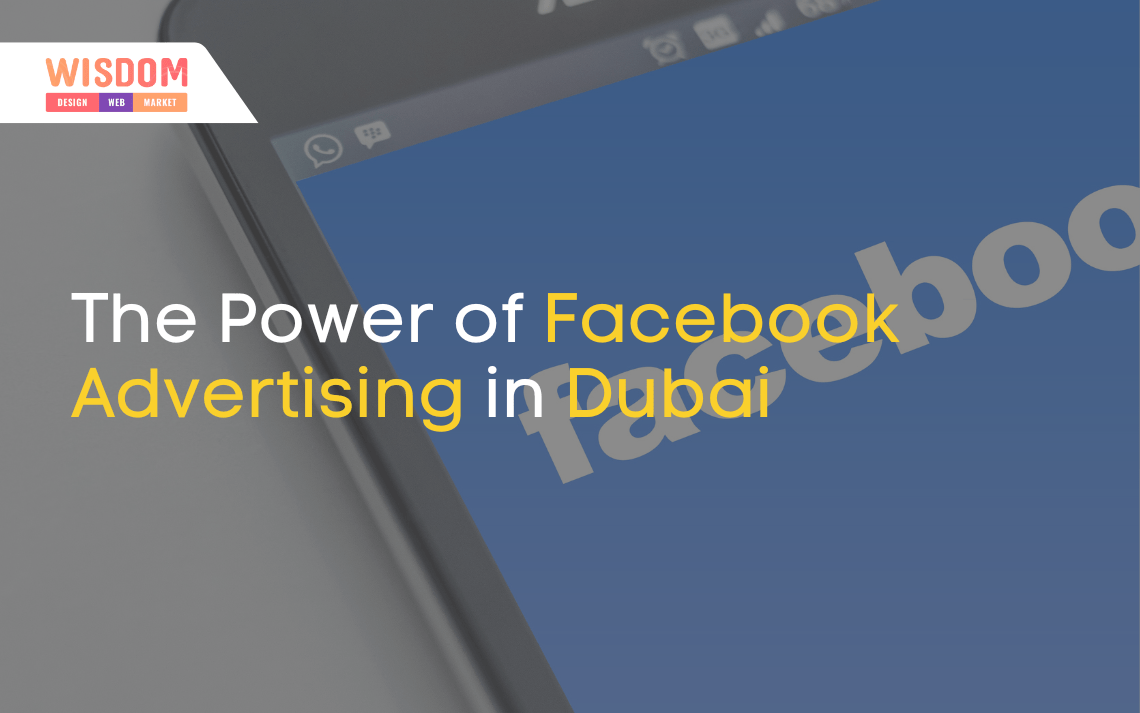
Digital Marketing Trends to Look Out for in 2023

The world of digital marketing is constantly evolving, and it’s essential to stay ahead of the curve to remain competitive in the marketplace. Keeping up with the latest trends is key to staying ahead of the game, and 2023 promises to bring some exciting new opportunities. Here’s a look at the top digital marketing trends to keep an eye out for in 2023 and what you need to know now to make sure you’re prepared. From artificial intelligence and machine learning to personalization and influencer marketing, there’s a lot to consider when it comes to staying ahead of the digital marketing trends of 2023. Understanding the latest trends can help you create a strategy that will keep you ahead of the competition and maximize the impact of your digital marketing efforts. Keep reading to learn more about the top digital marketing trends to look out for in 2023 and how you can prepare now.
With each year, digital marketing trends continue to evolve and bring new opportunities for businesses to reach their customers in better and more engaging ways. As we look ahead to 2023, it’s important to stay ahead of the curve by understanding what trends may be on the horizon. This article will provide insight on digital marketing trends to look out for in 2023, including the use of artificial intelligence, personalization, and video content. By understanding these trends now, you’ll be able to plan ahead and prepare your business for success in the coming year. So, if you’re looking for ways to stay ahead of the competition and refine your digital marketing strategy for 2023, read on to learn what you need to know now!
Digital Marketing Trends to Look Out For in 2023
As the digital space continues to evolve, there are some key trends you need to be aware of to make sure your business can stay ahead of the competition. With the dawn of a new year, now is the perfect time to review and update your marketing strategies. From predictive analytics to interactive content, there are some upcoming trends that you should be aware of in order to stay ahead of the competition. Here, we’ll take a look at the digital marketing trends that you should be keeping an eye on in the coming year. We’ll discuss how they’ll impact the way you market your business, and how you can prepare for them now. With the right preparation, you’ll be able to get a head start on the competition and make the most of the opportunities that digital marketing will offer in 2023.
Marketing in Metaverse
The concept of the Metaverse is an ever-evolving one, with many people and companies offering different interpretations. Broadly speaking, the Metaverse is a persistent, shared, virtual world that could eventually replace the existing internet. It is built on various kinds of 3D technology, real-time collaboration software, and blockchain-based decentralized finance tools.
The metaverse is a digital ecosystem that offers users a sense of agency, social presence, and shared spatial awareness, allowing them to create their own virtual spaces and interact with others online. This could include gaming, virtual meetings, or even socializing in 3D virtual environments.
In order to make the Metaverse a reality, seven key technologies are being used to power it: blockchain, cryptocurrency, augmented/virtual reality, artificial intelligence, 3D reconstruction, the internet of things (IoT), and edge computing & 5G. Each of these technologies works together to make the Metaverse a more immersive and realistic experience for users.
The metaverse has taken digital marketing by storm, revolutionizing the way people engage in immersive virtual experiences online. From Starbucks, Disney, Gucci, and Nike to countless other big brands, its impact can be felt everywhere – the metaverse is undoubtedly the future of virtual interactions. The metaverse has sparked much enthusiasm, but for many businesses, its practical uses and potential ROI remain largely untapped.
What can you do now? Explore the metaverse and take the plunge personally. Seek out fresh possibilities for your business to get involved and keep an eagle eye on your competitors. The metaverse is still largely uncharted for most businesses, so don’t worry about jumping in with both feet just yet.
Take a Look at some real case examples at https://www.practicalecommerce.com/12-examples-of-brands-in-the-metaverse

Predictive Analytics
Predictive analytics is a type of artificial intelligence that uses machine learning to predict future events based on past data. It is increasingly being used in digital marketing to understand customer behavior and make predictions about future customer behavior. These predictions can be used to inform a range of different marketing strategies including email marketing, content marketing and paid advertising. Predictive analytics can help businesses tailor their marketing strategies to suit each individual customer’s needs. This can be particularly useful for eCommerce businesses that rely heavily on conversion rates. Predictive analytics can help businesses understand what factors are most likely to lead to a purchase. This information can then be used to optimize their website and increase the number of people who make purchases. Predictive analytics can also be used to identify potential customer segments. This can help brands tailor their marketing strategies to specific groups of individuals. Predictive analytics will only become more important in the years to come. As machine learning and AI develop further, they will become an essential part of digital marketing strategies.
5 proven benefits of Predictive Analytics are:
- Helps to detect and prevent fraud and other online threats.
- Makes more accurate and reliable decisions.
- Helps to optimize marketing campaigns.
- Enables businesses to analyze customer behavior and product demand.
- Helps in upselling and cross-selling to customers.

Interactive content
Interactive content is content that allows readers or viewers to actively participate in the content. It can include a range of different features such as:
- Quizzes
- Games
- Calculators
- Contests
- Assessments
- Interactive maps
- Interactive videos
- Interactive infographics
Interactive content has been steadily growing in popularity over the past few years, and it’s likely to continue to grow even more in popularity in the coming years. Interactive content is particularly useful for brands that want to create content that is likely to be shared among multiple people. As more people get used to sharing and engaging with interactive content, brands will likely find opportunities to incorporate interactive content into their marketing strategies. As interactive content becomes more popular, brands will have to compete with other brands to get their content in front of people. By starting to plan how you can incorporate interactive content into your marketing strategies now, you’ll be able to stay ahead of the competition and make the most of these opportunities.

Voice & Visual Search
Voice and visual search are types of search that rely entirely on audio and visual cues rather than keywords. This is an approach that has been steadily gaining in popularity, although it is expected to become much more popular in the future.
Google, Pinterest, and several other corporations have invested heavily in the emerging trend of visual search technology. In fact, images are already returned for an impressive 19% of searches made on Google, and an even more astounding 62% of millennials have expressed more interest in visual search than any other new technology.
Voice and visual search are particularly useful for people who are using their mobile devices to search for information, as typing is difficult on a small screen. As more people turn to voice and visual search, marketers will need to adjust their strategies to accommodate these new methods of searching. This will likely lead to a decrease in organic search traffic, meaning that marketers will have to rely more on paid search. To optimize for visual and voice search, marketers will need to incorporate visual images and audio clips into their content in addition to keywords. This will likely lead to an increase in video content, both on websites and on social media platforms. Visual and voice searches will also likely lead to an increase in user-generated content, with people creating content that is relevant to specific searches that they have done. This will create new opportunities for businesses to engage with customers, although it will also require brands to adjust their strategies for staying ahead of the competition.

Personalization
Personalization is the process of tailoring content and marketing strategies to suit each customer. This can include everything from tailoring landing pages and email marketing campaigns to using a customer’s name in conversations. Personalization is likely to become more important as more people use voice and visual search to find information. With visual and voice searches, brands will need to rely on their ability to use personalization to stand out from the crowd. This will likely lead to a decrease in the number of people who engage with impersonal marketing content, meaning that businesses will have fewer opportunities to reach their target audiences. Personalization is also likely to become more important as businesses start to use artificial intelligence and predictive analytics to tailor their strategies to individual customers. Personalization allows brands to tailor content to specific customers, enabling them to stand out from the crowd and increase the likelihood of a purchase. As more businesses use AI and predictive analytics to tailor their strategies, the need for personalization will increase even further. With so many strategies competing for each customer’s attention, brands will need to rely on personalization to stand out from the crowd.
With a bit of extra effort, you can achieve incredible outcomes! In fact, 80% of shoppers said they were more likely to do business with a company that provides a personalized experience, according to Epsilon’s survey.

Video Content
Video content is becoming an increasingly important part of many digital marketing strategies. This is expected to continue to be the case in the years to come. With new technologies like artificial intelligence and machine learning becoming more common, marketers are likely to use more video content in their strategies. This will likely increase the demand for video content, meaning that businesses will need to find new ways to create video content for their marketing strategies. We’ll likely see an increase in the number of businesses hiring video production companies in the years to come. Video content is particularly useful for a wide range of industries, making it likely to become even more popular as time goes on. Video content is particularly useful for product or service demonstrations, as well as for building trust and authority among customers. This makes video content a particularly useful tool for eCommerce businesses, as well as brands in other industries. As video content becomes more common, businesses will have to find ways to stand out from the crowd.
Short Videos
The power of short videos is undeniable: starting with TikTok, which stormed social media, now YouTube, Facebook, and Instagram have all embraced this trend.
Live Streaming
When we factor in the live element, video becomes an even more engaging way for consumers to learn about new products, as the audience feel like they are part of it, having the potential to influence the content, instead of simply being a passive viewer.
Live streaming is proving to be a powerful tool for marketers. Recent studies have revealed that in 2021, consumers spent an incredible 548 billion hours streaming on mobile devices. Through live streaming, brands can now leverage influencers to create an engaging and interactive experience for their potential customers. Not only can these viewers learn about a product from familiar influencers, but they can also chat and make a purchase – all while watching the stream.

Automation & AI
Automation is a type of software or programming that allows businesses to run without human intervention. It can be used to manage various aspects of a business, including marketing campaigns. As automation becomes more popular, it is expected to become increasingly common in marketing strategies. This is particularly true as more businesses start to use artificial intelligence. As AI becomes more common, businesses will likely start to rely on it for various functions, including marketing. This will likely lead to an increase in the number of businesses using automation for marketing, meaning that marketers will have to compete with other businesses for attention. As automation becomes more common, it will likely become increasingly important that brands stand out from the crowd and attract attention from potential customers. This will mean that businesses will need to be especially creative to attract the attention of potential customers without using the same tactics as their competitors.
Reaping the rewards of AI technology, marketers are discovering the multitude of benefits it offers, such as.
- Advertising with heightened precision and intelligence.
- Unveiling of Precise Patterns and Forecasts
- Gaining Insight into Consumer Habits
- Gaining greater customer commitment and devotion.
- Take advantage of improved self-service abilities!
- Achieving a greater Return on Investment through precise targeting.

Omnichannel Marketing
Omnichannel marketing refers to a strategy that integrates different channels and marketing mediums, such as email, social media and content marketing. This allows marketers to communicate with customers across multiple channels and increase engagement with the brand. As more brands start to adopt omnichannel marketing, it is likely to become increasingly important that businesses use similar strategies. This will make it easier for customers to engage with brands across multiple channels, and increase the likelihood of brand loyalty. As more brands start to use omnichannel strategies, it will become increasingly important that businesses implement them in similar ways. This will help customers to engage with the brands across multiple channels, and make it easier for them to stay engaged with the brand. As more brands adopt this approach, businesses will need to ensure that their strategies are consistent across all channels. This will help brands stay consistent and keep their audiences engaged. In the years to come, businesses will need to be prepared to adopt omnichannel marketing strategies to stay competitive.

Social Media Storytelling
Social media storytelling is an effective way to engage with your audience and build a connection with them. It enables you to showcase your brand’s values, mission, and story in an authentic way. The key to successful social media storytelling is to focus on the “Four P’s”: People, Place, Plot, and Purpose. This will allow you to create stories that are meaningful and engaging for your audience. When creating stories for social media, it is important to keep in mind that the stories don’t have to be fictional. They can be about real life experiences such as customer testimonials or case studies. Additionally, there are various ways to tell stories on social media such as through videos, images and text. When crafting your stories, make sure that they have a beginning, middle and end with a climax or conflict. This will create interest and anticipation for the outcome of the story. Furthermore, try to add a moral lesson, thought or belief to the story so that it resonates with your audience. Finally, consider using different types of content to tell your stories such as polls, quizzes, coupons or UGC (user-generated content). This will create a more interesting and interactive experience for your audience. Storytelling is an art form and when used correctly on social media platforms, it can help you build relationships with your audience and elevate your brand.

Final thoughts
As automation becomes more prevalent, businesses will need to find creative ways to stand out from the competition and attract attention from potential customers. This means that marketers should focus on using AI technology to its fullest potential, such as using precise targeting and omnichannel marketing strategies. Additionally, brands should also focus on social media storytelling to create meaningful connections with their audiences. By following these strategies, businesses will be able to stay competitive and make sure they have a successful future.



